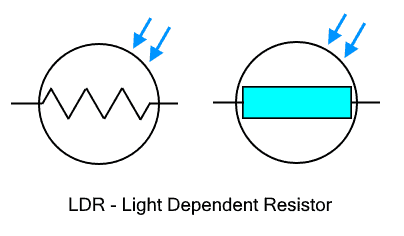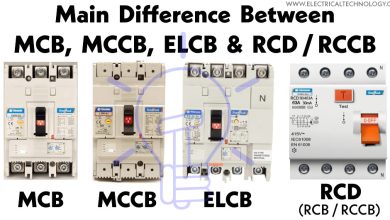Difference Between Phototransistor and Photoresistor (LDR)
What is the Difference Between Photoresistor (LDR) and Phototransistor?
Photoresistors and phototransistors are both a type of photosensors that allow current flow when light falls on them. However, they are quite different than each other in several characteristics such as operation, structure and various electrical characteristics.
Before going into the differences between the photoresistor and phototransistor. Let’s explain their basics first.
What is Photosensor?
A photosensor is a device whose electrical characteristics vary with the change in the intensity of the incident light. There are different types of light sensors used in electrical and electronic devices. A photoresistor or LDR and phototransistor are both types of photosensors.
Related Posts:
- Difference Between Photodiode and Phototransistor
- Difference between Photodiode and Photoresistor (LDR)
Photoresistor (LDR)
A photoresistor also known as LDR (light dependent resistor) or photocell is a light-sensitive device whose resistance varies with the intensity of light. It is a semiconductor-based component made of photoconductive material whose resistance varies inversely with the intensity of light.
Photoresistor works on the principle of photoconductivity. In dark or no-light conditions, its resistance is around 10Mohms while in light conditions, its resistance drops down to a few ohms.
It is made of only a single layer of N-type semiconductor material that has photoconductive properties such as Cadmium selenide CdSe and cadmium sulphide CdS. The material is formed into a strip and placed in a zigzag pattern that determines its power ratings.
Characteristics of Photoresistor
Here are some characteristics of a photoresistor
- It has very high sensitivity but it is easily affected by the change in temperature
- It is a passive component that consumes very low power.
- It is smaller in size and cheap.
- It has a simple design.
- It is bidirectional i.e. it can conduct in both directions. There it can be used for the conduction of both AC and DC
- It does not require biasing and is easily connected to the circuit.
- It has a slower response time as it cannot keep up with sudden changes in light intensity.
- It can sense a very narrow bandwidth of the intensity of light.
Related Posts:
- What is LDR – Light Dependent Resistor? Construction, Working, Types and Applications
- What is an Optocoupler or Opto-isolator – Working And Applications
Phototransistor
A photoresistor is a semiconductor-based light-sensitive device whose output current depends on the intensity of light striking it. It is a type of transistor with a light-sensitive base. It converts the light energy into base current which controls the current flow between the collector and emitter of the phototransistor.
Phototransistor amplifies the base current into its collector current. Since base current depends on the light intensity, the collector current varies with the intensity of light. They are used for sensing light pulses of high speed and small magnitude. It is similar to BJT except for the exposed base instead of a terminal.
It has either two or three terminals: collector, emitter and base (optional). The two-terminal Phototransistor does not include the base terminal. The base terminal is used for using it as a normal transistor in no light conditions or adjusting its sensitivity. Otherwise, it is left disconnected.
It is made of three alternating semiconductor layers that either form PNP or NPN. It is unidirectional i.e. only conducts DC current. It can be bipolar or field effect transistor.
Phototransistor works on the principle of the photovoltaic effect. According to this phenomenon when photons strike a semiconductor junction, electron-hole pair is generated that produces the base current in the phototransistor. This current is amplified into the output collector current.
In no-light conditions, it conducts a small amount of leakage current called dark current. It depends on the temperature of the junction.
Related Posts:
- What is Phototransistor? Construction, Working, Types and Applications
- What is a Laser Diode? Construction, Working, Types and Applications
Characteristics of Phototransistor
Here are some characteristics of Phototransistor
- It is a type of transistor that works on the light.
- Light striking the base generates the base current that is amplified into the collector current.
- It has either two or three terminals emitter, collector and base. Generally, there is no base terminal since it is controlled by light.
- If the base terminal is connected, it acts as a normal BJT.
- Under no light conditions, there is a flow of leakage current called dark current that depends on temperature.
- It has high sensitivity with a very fast response time.
- The collector-emitter junction voltage can permanently damage the device if it exceeds the breakdown voltage.
- It can operate in either active or switch mode. In active mode operation, it acts as an amplifier while in switch mode it is either in “On” or “Off” state.
- It is not suitable for high frequency due to its large junction capacitance due to the large base and collector region.
- The collector is maintained at a higher voltage than the emitter to make the B-C junction reverse and B-E junction forward bias.
Related Posts:
Main Differences between Photoresistor & Phototransistor
The following table show the key differences and comparison between phototransistor and photoresistor (LDR).
| Photoresistor (LDR) | Phototransistor |
| It is a variable resistor whose resistance varies with the intensity of light. | It is a transistor whose collector current is proportional to the intensity of light. |
| It has two identical terminals. | It has two different terminals named collector and emitter. |
| It is a bidirectional device that allows current in both directions. | It is unidirectional. |
| It can conduct both DC as well as AC. | It can only conduct DC current. |
| It is a passive component that does not consume power. | It is an active component that requires biasing |
| There is no current amplification. | It amplifies the base current. |
| It has a slow response time. | It has a fast response time. |
| It has lower sensitivity than phototransistor. | It has high sensitivity. |
| Under no light conditions, it exhibits relatively lower resistance. | It has relatively very high resistance. |
| In light conditions, it exhibits relatively higher resistance. | While it has lower resistance. |
| Temperature greatly affects the resistance of the photoresistor. | The temperature has a lower effect on a phototransistor. |
| It has a higher current carrying capacity. | It has a lower current carrying capacity. |
| It is costlier than a phototransistor. | It is cheaper than a photoresistor. |
We can conclude that both the photoresistor and phototransistor can be used in light-sensitive circuits but the given differences must be considered before choosing the appropriate photosensor that would be efficient and economical for any specific application.
Related Posts:
- Difference Between Schottky Diode and Fast Recovery Diode
- Differences Between Encoder and Decoder?
- Difference Between CPU and GPU – Comparison
- Difference Between RAM and ROM – Comparison
- Difference Between JFET and MOSFET
- Difference Between D-MOSFET and E-MOSFET
- Difference Between BJT and FET Transistors
- Difference Between NPN and PNP Transistor
- Difference Between DIAC and TRIAC
- What is The Difference Between Transistor and Thyristor (SCR)?
- Differences between Active and Passive Filter
- Difference Between Multiplexer (MUX) and Demultiplexer (DEMUX)
- Difference Between Diode and SCR (Thyristor)
- Difference Between Diode and Transistor
- Difference Between Microprocessor and Microcontroller
- Difference Between 8085 and 8086 Microprocessor – Comparison
- Difference Between Schottky Diode and Shockley Diode











